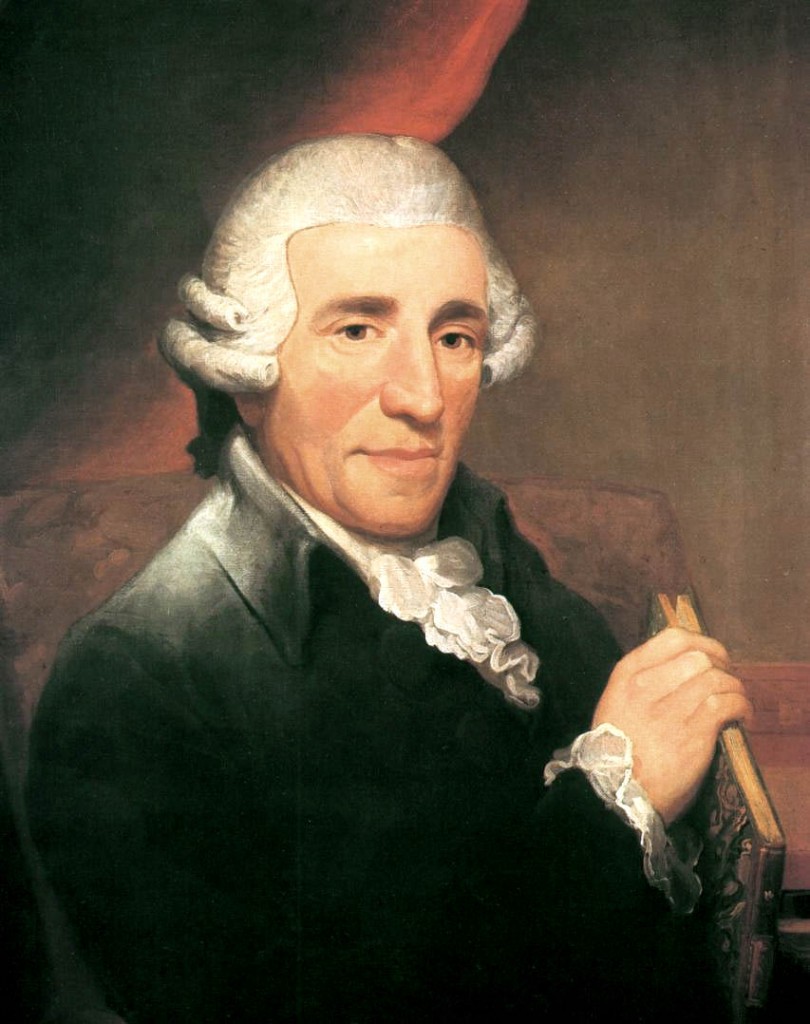Joseph Haydn (1732-1809)
Born March 31, 1732 in Rohrau Austria.
Died May 31, 1897 in Vienna Austria.

Symphony No. 88 in G Major.
Composed: 1787.
First Performance: Paris, 1787.
Instrumentation: 2 flutes, 2 oboes, 2 bassoons, 2 horns, 2 trumpets, timpani, and strings.
Duration: ~25 min.
Haydn wrote five symphonies between his celebrated Paris[82-87] and London[93-104] symphony collections. The Symphony No. 88 was written after Haydn returned to Hungary from Paris and is one of his most popular works. In Britain this symphony is known by the nickname “Letter V” which refers to the catalog of the Royal Philharmonic Society in London.
In September 1788 Haydn wrote to his Viennese publisher “I was told that you… purchased from Herr Tost my very newest 6 quartets [op. 54 and 55] and 2 new Symphonies [Nos. 88 and 89]. … I would like to know if this is true or not…” The 88th and 89th symphonies, were dedicated to Johann Tost, a violinist in the orchestra of Haydn’s patron Prince Esterházy. He had left Esterházy to go to Paris taking with him several of Haydn’s works including these symphonies. Haydn did give Tost the right to seek publication for these works. But it turned out that Tost was an unprincipled scoundrel. Haydn’s letters to the Paris publisher Sieber reveals that not only was Haydn not paid for the publication of these works but that Tost had sold not only other Haydn’s works to which he did not have rights but passed off works by other composers as works of Haydn. What is remarkable is that by 1790 this affair seems be have been settled since Haydn dedicated his op 64 string quartets to Tost who was by then no longer a violinist but a wealthy merchant.
There are four movements:
I. Adagio, Allegro
II. Largo
III. Menuetto, Allegretto (Trio)
IV Finale: Allegro con spirito
The first movement begins with a G major adagio (slow) introduction in 3/4. After the introduction the mood changes immediately The meter changes to 2/4 and the tempo is now allegro but still in G major. The main theme enters played softly by the strings, then full orchestra forte with a new motif introduced in bass. This motif is developed along with the main theme. The rhythm of the main theme is a striking recognizable feature which provides the opportunity for extensive development. There are two more themes but they are essentially variants of the main theme. The movement ends with a coda based on the main theme.
The Largo second movement is in D major and in 3/4. The elegant simple main theme is first presented by the oboe and celli followed by a charming series of variations. Of this theme Brahms remarked “I want my ninth symphony to sound like this.” In England this theme became a church hymn.
The very presence of trumpets and timpani in a G major symphony in the 1780s was quite unusual. The trumpets of that time were essential simply a coiled tube without valves which were not introduced until the 1830s. These “natural” trumpets were limited to only a few pitches and the tessitura of G trumpets were quite high. In this movement D trumpets are employed and C trumpets for the remaining movements. (Haydn’s Trumpet Concerto from the following decade was written for a “keyed trumpet” in Eb). The audience was surprised to see them and doubly surprised that they made their entrance in the quiet slow movement instead of the ebullient outer movements. Of course we know that Haydn was no stranger to incorporating “surprises” into symphonies.
The third movement is a minuet (in 3/4 as expected) and moves back to G major. But here the character of the minuet is more of a rustic peasant dance than a gracious, perhaps effete setting that would commonly be heard in Europe’s noble courts of the time. In the trio we hear a drone moving in parallel fifths played by the bassoons and violas which earned it the nickname in Germany “mit dem Dudelsack.”
The Allegro con spirito finale like the first movement is in G major and in 2/4. It does not thunder onto the scene; instead the peasant dance-like main theme enters softly as it does in the first movement. This theme has recently taken on a life of its own. It is quite popular with amateur guitarists – most of whom have no idea whence it came! Haydn was fond of using the Rondo form for his finales. The rondo structure (ABACA etc.) is recognizable but Haydn does not simply repeat materials. We are treated to interesting and varied treatments of the theme including a quite exciting canon. There is a brief pause at the end of the canon before the orchestra begins a vigorous mad dash to the end.
Resources
[amazon template=iframe image&asin=3795771595][amazon template=iframe image&asin=0769282016]
[amazon template=iframe image&asin=B000007S7C][amazon template=iframe image&asin=B0000012VH]
Public domain score.
What is your source for the theme of the 2nd movement of Haydn’s Symphony No. 88 becoming a church hymn in England? What is the name of that church hymn?
“Its religious mood has raised it in England to the position of a church anthem (Praise God, from whom all blessings flow).
Its impression on Beethoven was so strong that he used in several cases for his own purposes.”
Dr. Ernst Praetorius
November 1936
I am not Anglican/Episcopalian, so I don’t know how many anthems have that title, but I think there must be more than one because the theme in Haydn doesn’t sound like the ear worm I have when I read that title.